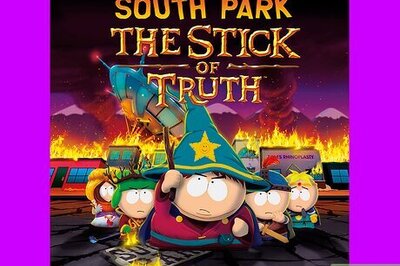
views
The world's largest democratic exercise has just taken off with over 81.45 crore voters eligible to elect 543 candidates for the 16th Lok Sabha.
The 36 days long voting process began on Monday (April 7) in 6 Lok Sabha constituencies of Assam and Tripura and will finally conclude more than a month later on May 12. The results will be declared on May 16 after which India will get a new government.
Due to the large size of electorate and security concerns in various regions of the country, the Election Commission of India (ECI) is conducting the polls in 9 phases spread over 36 days for 543 Lok Sabha seats. India's 16th Lok Sabha election is being keenly watched across the world for various reasons.
For the first time since Indira Gandhi days, the Parliamentary election has taken the form of a presidential election with one man being the centre of all attention. BJP's Prime Ministerial nominee Narendra Modi has made it a fight between him and all other opposition parties rather than a fight between the BJP and others. In fact Modi has completely overshadowed every other issue, even his party with and has been seeking vote in his name for what he says will ensure that India finally gets a strong and able government to tackle all the ills plaguing the country.
According to some longtime Congress watchers the oldest political party in the fray is going to polls totally 'dis-spirited' for the first time. Some of its top leaders have even refused to contest in the elections, fearing defeat burdened by the 10-year long anti-incumbency, corruption scandals and a weak and ineffective government.
The Aam Aadmi Party (AAP) which has fielded the highest number of candidates after the Congress and the BJP seems to have lost its sheen and all pre-poll surveys are predicting its debacle.
The BJP anointed Gujarat chief minister Narendra Modi as its PM nominee in September 2013. The sulking BJP patriarch LK Advani is once again contesting from Gandhinagar in Gujarat and he is not expected to play any big role after the elections, if the BJP-led NDA which has managed to ally with several new parties in the last couple of months manages to get more than 230-240 Lok Sabha seats. In case the BJP stops at 200 seats or less than 200, Advani may play a bigger role in stitching up an alliance.
The Congress campaign is led by party Vice President Rahul Gandhi. He has been extensively campaigning for the party for over 6 months and is addressing 3-4 big public meetings at different parts of the country every day. His mother and Congress president Sonia Gandhi is also campaigning for the party. However, after its humiliating defeat in the Assembly elections in December 2013, the Congress seems to have lost the will to fight back.
Regional parties and poll calculations
In large part of India, regional parties are giving a tough fight to both the Congress and BJP. In Tamil Nadu, two major Dravidian parties AIADMK and DMK are facing the polls without having an alliance with any national political party. The isolated Congress is facing the voters on its own. The BJP has managed to cobble up an alliance with smaller Dravida parties like DMDK, MDMK and PMK etc.
In West Bengal and Kerala, the Left is fighting a tough battle for its very survival. All pre-poll surveys are predicting a big win for the TMC led by West Bengal Chief Minister Mamata Banerjee. In Kerala the Congress-led UDF is expected to do well this time too. The Left looks formidable only in the tiny Northeastern state of Tripura, which has just two Lok Sabha seats.
In divided Andhra Pradesh, the YSR Congress led by YS Jagan Mohan Reddy and the N Chandrababu Naidu-led TDP are fighting for the first two spots. The Congress is likely to be decimated here and the BJP is a marginal force.
In Telangana, which will be India's 29th state from June 2, 2014, the TRS led by the charismatic K Chandrashekhararao is going solo. It is engaged in a tough battle with the Congress.
In neighbouring Karnataka, the JDS led by former PM HD Deve Gowda is not expected to do well this time with the main fight between Congress and BJP.
In Maharashtra, the ruling Congress-NCP alliance is fighting a tough battle with the resurgent BJP-Shiv Sena-RPI(A) alliance.
In MP, Rajasthan, Chhattisgarh and Gujarat, the ruling BJP is looking extremely strong and the Congress is likely to do very badly.
In two key battleground states of UP and Bihar, the BJP is expected to do very well. Both the states are witnessing a multi-cornered contest in which the ruling parties SP and JDU are expected to fare very badly.
In the national capital Delhi, the BJP is likely to win more seats than its principle rival AAP. The Congress is staring at a defeat once again.
In Haryana, the BJP-HJC alliance is ahead of the ruling Congress and the INLD led by Chautalas is not doing well.
In Punjab, the ruling SAD-BJP alliance is doing well and expected to win more seats than the Congress.
In the two Himalayan states of Uttarakhand and Himachal Pradesh, the BJP and Congress are engaged in a close fight.
In Jammu & Kashmir, the National Conference, the PDP, the BJP and the Congress are engaged in a multi-cornered fight.
In Jharkhand, the BJP is likely to do well by giving a tough fight to the ruling Congress-JMM alliance.
In Odisha, BJD supremo and Chief Minister Naveen Patnaik is seeking a fourth straight term as the CM. Pre-poll surveys have predicted his victory in both Assembly and the Lok Sabha elections.
In Northeast, the Congress is expected to do well in Assam, Meghalaya, Manipur, Mizoram and Arunachal Pradesh. The ruling Naga People Front (NPF) is ahead in Nagaland.
In Sikkim, the ruling SDF is likely to retain power for the fifth straight term.
More than 20 former chief ministers, two serving chief ministers and a former Prime Minister are also in the fray in the Lok Sabha elections.
The BJP's PM nominee Narendra Modi is the serving CM of Gujarat. Nagaland CM Neipo Rio is also contesting in the Lok Sabha elections.
The only former prime minister in the fray is 82 years old HD Deve Gowda, who is fighting his 15th direct election in the last 52 years.
Key issues
Narendra Modi is running a Presidential type of campaign asking the people to vote for him. He is attacking the ruling Congress on economic and security related issues, promising the voters a clean, efficient and strong government.
The major scams like 2G, Coalgate and Commonwealth Games etc are being mentioned by Modi all over India.
He is also talking about sluggish economy, below 5 per cent growth rate, rising unemployment, soft policy towards terrorism etc.
Modi is trying to woo the young, educated first time voters by using the social media in a big way. According to latest figures, there are more than 10 crore first voters in the country and most pre-poll surveys are predicting that many of them will vote for the BJP.
Modi is trying to sell his Gujarat 'model' to rest of the country. The BJP is also releasing its manifesto on Monday.
The ruling Congress has already released its manifesto. The manifesto promises all-round economic growth, stability, inclusive growth, religious tolerance and more facilities for the rural areas.
It also promises a huge investment in infrastructure.
National picture
Most pre-poll surveys have predicted the NDA victory and the UPA defeat in the polls. CNN-IBN, CSDS, Lokniti and The Week national election tracker has also predicted the victory of the NDA and a massive defeat for the ruling UPA.
Voting time
The voting begins at 7 AM and ends at 6 PM in most parts of the country. In Naxal affected areas the voting ends at 4 PM.
Poll facts
Total Lok Sabha Seats - 543
Polling in 9 Phases between April 7 and May 12
Spread over 36 days. The 2009 LS polls had 5 Phases.
Result - May 16
Eligible number of voters - Almost 82 crore
10 crore are first time voters.
Election Personnel - More than 1.1 crore
Polling Stations - 9,30,000 across India
Electronic Voting Machines (EVMs) - 14,68,430
Vials of indelible ink likely to be used this time - 2.2 million
Largest Constituency by size - Ladakh in J&K
Smallest Constituency by size - Chandni Chowk in Delhi
Largest by voters - Malkajgiri in Andhra Pradesh with around 29.5 lakh voters;
Smallest by voters - Lakshadweep with 47,972 voters
Top candidates in the fray
BJP
Narendra Modi
LK Advani
Sushma Swaraj
Arun Jaitley
Murli Manohar Joshi
Rajnath Singh
Nitin Gadkari
BS Yeddyurappa
Ananth Kumar
BC Khanduri
Uma Bharti
Gopinath Munde
General VK Singh
Congress
Rahul Gandhi
Sonia Gandhi
Sushil Kumar Shinde
Kapil Sibal
M Mallikarjuna Kharge
M Veerappa Moily
Jyotiraditya Scindhia
Sachin Pilot
Capt. Amarinder Singh
Ghulam Nabi Azad
CP Joshi
Madhusudhan Mistry
Milind Deora
Ashok Chavan
Karti Chidambaram
S Jaipala Reddy
Adhir Chaudhury
Meira Kumar
Jitin Prasada
RPN Singh
Nagma
Mohammed Azaruddin
Gaurav Gogoi
Shashi Tharoor
KV Thomas
Priya Dutt
Others
Arvind Kejriwal
Prof. Yogendra Yadav
Mulayam Singh Yadav
Misa Bhart
HD Deve Gowda
HD Kumaraswamy
Dayanidhi Maran
A Raja
Supriya Sule
Chagan Bhujbal
Medha Patkar
Amar Singh '
Jaya Prada
Ajit Singh
Shibu Soren
Jay Panda
Kavitha Rao
E Ahamad
Moon Moon Sen
PC Sorkar
Assembly elections in 4 states
Andhra Pradesh (Telangana will become a separate state after the elections)
Odisha
Sikkim
Arunachal Pradesh


















Comments
0 comment